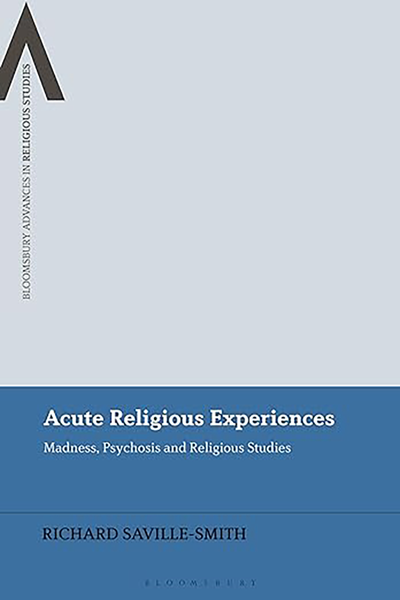
The relationship between religion and psychiatry has long been a troubled one. These troubles have spilled over into clinical practice to the detriment of patients who (by and large) are more likely to be religious than the mental health professionals who treat them. Religious beliefs and experiences have too readily been pathologised by psychiatrists, and patients are subjected to epistemic injustices which only add to the already significant stigma and marginalisation that they experience in their faith communities and in wider society. Acute Religious Experiences offers a constructive contribution to the ongoing debate.
Richard Saville-Smith self-identifies as a ‘mad person’ seeking to ‘introduce mad studies to religious studies’ (p. 1). His ‘central argument is that the visions, voices and possessions which psychiatry pathologizes can sometimes be better read as non-pathological’ (p. 2).
Part I explores seven contributions from 20th-century authors offering non-pathological accounts of ‘extraordinary/anomalous/extreme’ experiences. Some of these texts (e.g. Abraham Maslow on peak experiences) will be well known to virtually all psychiatrists. Others are less well known (e.g. Walter Pahnke's study of psychedelic experience, William James’ Varieties of Religious Experience or Mircea Eliade's Shamanism). Yet others, although seminal texts in religious studies, are rarely encountered in psychiatric literature (e.g. Rudolf Otto's Idea of the Holy).
In Part II, successive chapters address the Diagnostic and Statistical Manual of Mental Disorders (DSM-5), Michel Foucault's History of Madness and the core proposal of the book, the concept of Acute Religious Experiences. The DSM-5 is seen as an ‘epistemological prison’ (p. 110) which fails to acknowledge the possibility of ‘non-pathological psychosis’ (p. 122). More positively (amongst criteria for Dissociative Identity Disorder) the term ‘disruption’ is identified as useful, having ‘some of the hallmarks of madness’ (p. 116), yet is not itself a basis for a diagnosis. Where Foucault's History failed to give the voiceless mad a voice, Saville-Smith argues, mad studies can do so. Experience of madness is akin to that of the numinous (Otto), the shaman (Eliade) or the mystic. A plea is made for the voices of madness to be given an equal footing (and equal funding) in the academy.
Acute religious experiences are characterised as non-pathological, transformative, overwhelming events of consciousness within a ‘capacious’ approach to what is religious. They are identifiable within a ‘DREAD’ framework: Diverse, Religious, Extreme, Ambivalent, Determination. I found some of the choices of words confusing. ‘Acute’ is not contrasted with ‘chronic’ but with ‘general’; it thus acts as a synonym for ‘extraordinary/anomalous/extreme’. ‘Ambivalent’ is used with reference to Bleuler's original understanding: a dynamic alternation of feelings and ideas which (lest it otherwise continue forever) is eventually resolved in a process of ‘determination’ of particular meaning (p. 166).
In Part III, Jesus is taken as a case study for application of the DREAD model. Saville-Smith finds two acute religious experiences in the Christian gospel according to Mark: the baptism of Jesus and an event known as the transfiguration (a visionary transformation of Jesus’ appearance). Saville-Smith identifies these events as ‘ictal’ (another confusing choice of term, not to be taken here as implying epilepsy, but rather it seems to refer to the religious experience as an event [p. 188]). Following the second event, Jesus is said to be ‘compelled, obligated, determined to die at the hands of the authorities’ (p. 190), but equally he is not suicidal. This is offered as an example of the disruption effected by the acute religious experience. Jesus is ‘driven by the hand of God’ (p. 190) to die ‘in the right place at the right time’ (p. 194) This novel interpretation fails to engage in any detail with critical biblical scholarship, but then that is not the purpose of the case study.
Saville-Smith resists the anachronistic application of DSM-5 criteria to Jesus and asserts that his agenda is not to pathologise. Nonetheless, if there is said to be religious meaning in madness, it might easily be inferred that religion is mad. Early in Part II we read that, for psychiatry, ‘religion per se is a delusion’ (p. 103). Referring to central tenets of Christian faith, Saville-Smith says that ‘such delusions can be and are tolerated’ (p. 103). Statements like this do not recognise that clinical definitions of delusion specifically exclude cultural and religious beliefs and may further alienate religious people from psychiatry. Neither are they sensitive to the nuances of theological epistemology.
Repeated reference is made through the book to 25% of patients in Western psychiatric wards who ‘articulate their experiences in religious terms’ (pp. 102, 134, 161, 169, 185). (They are referred to as being on ‘locked wards’ or in ‘secure units’, but the cited studies reveal that most were informal in-patients with psychosis.) Ironically these patients remain voiceless in Acute Religious Experiences. The author indicates briefly that his own experience of madness has been ‘not the aberration, it is the more, the numinous, the Shamanic consciousness, the mystical experience, the reality beyond the model offered by the psychotomimetic/psychedelic experience. Madness is the peak experience’ (p. 143). He feels that his privacy was infringed by PhD examiners who induced him to write more about these experiences than he wished to and so provides no detail about them in this book. Nor does he discuss the extensive published literature by, and about, other people who have had religious experiences while mentally ill.
I enjoyed reading Acute Religious Experiences. I did not always agree with its author, but it deserves to be read by all who are concerned about the troubled relationship between religion and psychiatry.



eLetters
No eLetters have been published for this article.